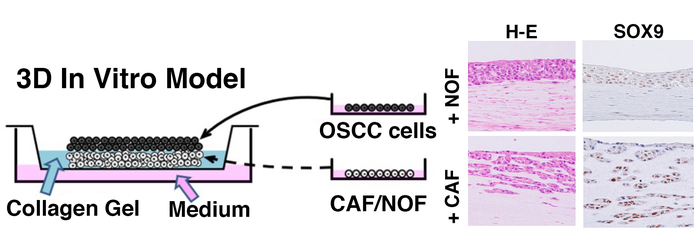Niigata, Japan – Oral malignancies represent the seventh most common cancer worldwide. Many diagnosed patients relapse, despite radical resection of the primary oral squamous cell carcinoma (OSCC) lesion. Therefore, understanding the local invasion mechanism is warranted in developing more effective therapeutic approaches, and identifying markers that predict poor prognosis.

Credit: Niigata University
Niigata, Japan – Oral malignancies represent the seventh most common cancer worldwide. Many diagnosed patients relapse, despite radical resection of the primary oral squamous cell carcinoma (OSCC) lesion. Therefore, understanding the local invasion mechanism is warranted in developing more effective therapeutic approaches, and identifying markers that predict poor prognosis.
Cancer tissues, containing neoplastic parenchymal cells and stromal components, are surrounded by the tumor microenvironment (TME), which promotes cancer progression and extracellular matrix remodeling, neoangiogenesis, and tumor growth. Cancer-associated fibroblasts (CAFs) are the major cellular component of the cancer stroma in TME. The specific growth factors/cytokines produced by cancer-associated fibroblasts (CAFs) induce the epithelial-mesenchymal transition (EMT) in cancer cells via a paracrine system.
A large number of CAFs is associated with poor clinical prognosis in various neoplasms. Besides, several studies have shown that the cancer stroma promotes the expression of Sex-determining region Y (SRY)-box9 (SOX9) in cancer cells through the transforming growth factor-β (TGF-β) signaling pathway and this high SOX9 expression correlates with poor prognosis in patients diagnosed with various cancers. However, the interaction between CAFs and cancer cells through the TGF-β/SOX9 axis has not been thoroughly investigated, especially in OSCC.
Professor Jun-ichi Tanuma and Dr. Manabu Yamazaki from the Division of Oral Pathology, Faculty of Dentistry & Niigata University Graduate School of Medical and Dental Sciences, Niigata, Japan, observed that 3D models, mimicking the morphological and intrinsic molecular properties, as well as the local microenvironment in vivo, may be more predictive of physiological cell behavior than conventional 2D culture systems. Therefore, Professor Tanuma and Dr. Yamazaki established a system for oral mucosa tissue engineering, containing OSCC cells and CAFs, to investigate the role of the TGF-β/SOX9 axis in CAFs and OSCC cells in promoting cancer progression in vitro and in vivo. In addition, Professor Tanuma and Dr. Yamazaki confirmed that the presence of α-SMA-positive CAFs in the cancer stroma was correlated with the clinical outcome and poor prognosis in OSCC patients and explored the mechanisms of cancer invasiveness and clues to develop novel therapies.
This study demonstrated that CAF-induced TGF-β1 upregulates SOX9 expression in OSCC cells through the paracrine TGF-β signaling pathway and promotes cancer migration and invasion in vitro and in vivo. Furthermore, Professor Tanuma and Dr. Yamazaki showed that the invading OSCC cells in the 3D in vitro models exhibited strong SOX9 expression associated with some changes in the expression of EMT markers and that pharmacological inhibition of TGF-β signaling and knockdown of SOX9 drastically reduced cancer invasion, suggesting that TGF-β-mediated invasion is dependent on SOX9 expression. Therefore, the TGF-β/SOX9 axis may modulate cancer migration and invasion induced by EMT.
Overall, the data presented by Professor Tanuma and associates underscore the crucial role of CAFs in cancer migration and invasion by inducing the EMT in cancers cells through a paracrine TGF-β signaling pathway. Professor Tanuma says about the present study: “The invading OSCC cells in our 3D in vitro models exhibited strong SOX9 expression with associated changes in the expression of EMT markers. Pharmacological inhibition of TGF-β signaling and knockdown of SOX9 drastically reduced cancer invasion, suggesting that TGF-β-mediated invasion is dependent on SOX9 expression. Therefore, the TGF-β/SOX9 axis may modulate cancer migration and invasion induced by EMT. In addition, histopathological investigations using OSCC surgical specimens revealed that the emergence of α-SMA-positive fibroblasts may be a useful marker for cancer invasion and poor clinical outcomes”. Professor Tanuma added that an early event in carcinogenesis is the generations of activated fibroblasts or CAFs, which are continuously exposed to different stimuli in the TME, are induced by cancer cells to secrete excessive and abnormal soluble factors and modify the stromal extracellular matrix. The current study showed that α-SMA expression is only localized to the stromal fibroblasts of OSCC and not to the normal epithelium, OED (oral epithelial dysplasia), or CIS (carcinoma in situ). Taken together, these results suggest that switching from normal fibroblasts to α-SMA-positive CAFs might occur in the steps before and after the invasion. Further investigation is required to establish more specific markers of CAFs in early OSCC for early carcinogenesis detection.
###
The article “Crosstalk between oral squamous cell carcinoma cells and cancer-associated fibroblasts via the TGF-β/SOX9 axis in cancer progression” was published in Translational Oncology at DOI: 10.1016/j.tranon.2021.101236
Journal
Translational Oncology
DOI
10.1016/j.tranon.2021.101236
Article Title
Crosstalk between oral squamous cell carcinoma cells and cancer-associated fibroblasts via the TGF-β/SOX9 axis in cancer progression
Article Publication Date
5-Oct-2021




